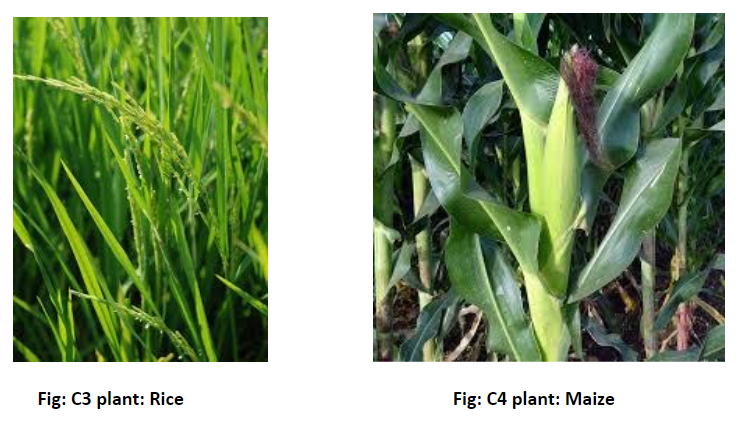
The exceptional difference between C3 and C4 plants is exhibited by the phenomenon
A. Photosynthesis
B. Photorespiration
C. Transpiration
D. Crassulacean metabolism
Answer
579k+ views
Hint: Transpiration is a very common phenomenon of water transport and photosynthesis is seen in all green plants. Crassulacean metabolism is seen in special types of plants that are usually seen in hot climate regions or places with high temperatures. Now, try to analyze where C3 and C4 plants are seen.
Complete answer: 1. In C3 plants, $O_2$ is driven directly into the Calvin cycle and leaves RuBisCO (Ribulose bisphosphate carboxylase/oxygenase) exposed to $O_2$.
2. RuBisCO then takes up $O_2$ and reacts with ribulose bisphosphate (RuBP) to produce 2-phosphoglycolate and 3-phosphogyceric acid. This whole reaction takes place in the chloroplast. The product 2-phosphoglycolate is a very toxic product and is of no use of plants. So, it undergoes certain chemical reactions to produce 3-phosphoglyceric acid.
3. The next set of reactions takes place in peroxisome and mitochondria where 2-phosphoglycolate converts to glycine and glycine convert to serine respectively.
4. The serine then comes to the peroxisome and converts to glycerate and this glycerate enters to chloroplast and produces 3-phosphogyceric acid.
5. Photorespiration occurs when concentrations of $CO_2$ is low and concentrations of $O_2$ is high.

6. C4 plants capture $CO_2$ is primarily captured by phosphoenolpyruvate or PEP in mesophyll cells to form oxaloacetate. This oxaloacetate is then converted to malate and transported to the bundle sheath cells, where oxygen concentration is low and releases $CO_2$, which is then taken up in the Calvin cycle. This mechanism is adopted by C4 plants to avoid photorespiration.
7. Photosynthesis is seen in all the green plants that have chlorophyll.
8. Transpiration is also seen in all plants to transport water that is absorbed from the soil by the root to the other parts of plants.
Crassulacean metabolism or CAM is only seen in Crassulaceae family plants, such as cactus.
So, the correct answer is option B. photorespiration.

Note: Transpiration takes place by xylem cells. Photorespiration takes place in chloroplast, peroxisome, and mitochondria. CAM pathway takes place in mesophyll cells during day and night. In C4 plants the $CO_2$ trapping and metabolism take place in both mesophyll cells and bundle sheath.
Complete answer: 1. In C3 plants, $O_2$ is driven directly into the Calvin cycle and leaves RuBisCO (Ribulose bisphosphate carboxylase/oxygenase) exposed to $O_2$.
2. RuBisCO then takes up $O_2$ and reacts with ribulose bisphosphate (RuBP) to produce 2-phosphoglycolate and 3-phosphogyceric acid. This whole reaction takes place in the chloroplast. The product 2-phosphoglycolate is a very toxic product and is of no use of plants. So, it undergoes certain chemical reactions to produce 3-phosphoglyceric acid.
3. The next set of reactions takes place in peroxisome and mitochondria where 2-phosphoglycolate converts to glycine and glycine convert to serine respectively.
4. The serine then comes to the peroxisome and converts to glycerate and this glycerate enters to chloroplast and produces 3-phosphogyceric acid.
5. Photorespiration occurs when concentrations of $CO_2$ is low and concentrations of $O_2$ is high.

6. C4 plants capture $CO_2$ is primarily captured by phosphoenolpyruvate or PEP in mesophyll cells to form oxaloacetate. This oxaloacetate is then converted to malate and transported to the bundle sheath cells, where oxygen concentration is low and releases $CO_2$, which is then taken up in the Calvin cycle. This mechanism is adopted by C4 plants to avoid photorespiration.
7. Photosynthesis is seen in all the green plants that have chlorophyll.
8. Transpiration is also seen in all plants to transport water that is absorbed from the soil by the root to the other parts of plants.
Crassulacean metabolism or CAM is only seen in Crassulaceae family plants, such as cactus.
So, the correct answer is option B. photorespiration.

Note: Transpiration takes place by xylem cells. Photorespiration takes place in chloroplast, peroxisome, and mitochondria. CAM pathway takes place in mesophyll cells during day and night. In C4 plants the $CO_2$ trapping and metabolism take place in both mesophyll cells and bundle sheath.
Recently Updated Pages
Class 12 Question and Answer - Your Ultimate Solutions Guide

A man running at a speed 5 ms is viewed in the side class 12 physics CBSE

The number of solutions in x in 02pi for which sqrt class 12 maths CBSE

State and explain Hardy Weinbergs Principle class 12 biology CBSE

Write any two methods of preparation of phenol Give class 12 chemistry CBSE

Which of the following statements is wrong a Amnion class 12 biology CBSE

Trending doubts
What are the major means of transport Explain each class 12 social science CBSE

Which are the Top 10 Largest Countries of the World?

Draw a labelled sketch of the human eye class 12 physics CBSE

Explain sex determination in humans with line diag class 12 biology CBSE

The pH of the pancreatic juice is A 64 B 86 C 120 D class 12 biology CBSE

Explain sex determination in humans with the help of class 12 biology CBSE




